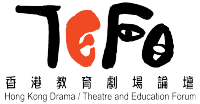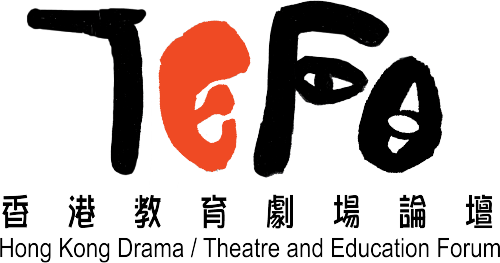Facilitation as a Worldview
By Valerie Jane Kwok
“Facilitation isn’t a problem-solving technique, it’s aworldview,” Chris Cooper asserts in the introduction to his three-day workshop.
Cooper expands on this statement by stating his belief that educators need to be more like facilitators rather than teachers, because the art of facilitation contains the pedagogical practice and theory that enables deep experiential learning and critical thinking in students. His three-day workshop brought a group of drama educators, social workers, actors and teachers together to explore the practice of facilitation of a Theatre-in-Education (TiE) drama.
On Day 1, Cooper kickstarted the workshop by bringing the participants through a TiE participatory drama that he wrote, named and based on the Greek myth of the Minotaur. He “twilighted” between his role as a facilitator, workshop leader and different dramatic roles in the story of the Minotaur, seamlessly transitioning between them in the process of unfolding this drama together with the participants.
Cooper would perform short scenes as specific roles of the story, for example as one of the young tributes that would be sacrificed to the Minotaur and King Minos. His portrayals were often no longer than 10-minute moments of each role’s actions in the story, with minimal spoken text and extended, slow body movement. He would draw attention to what the participants see during the roleplay, particularly the symbols, props, their usage, and the role’s body language.
He would then ask participants to “go beyond the information” that is given so far by putting their imaginative power to use. He tasked them with using paper and pen to map out the buildings and landmarks in city square that is built on top of the Minotaur’s labyrinth. Using masking tape to transform the entire workshop studio into the city square, Cooper then asked participants to use their bodies to depict the different citizens they could imagine being in the city in ensemble tableaus, constructing a collective imagination of this world of the participatory drama.
Finally, Cooper asked the participants to closely observe his roleplay as King Minos in the royal study overlooking the city that the participants have just built. As the final task for the day, he asked participants to depict King Minos, Pasiphae (his wife) and Ariadne (his daughter) in the study five minutes after the events of his roleplay. To facilitate this, Cooper broke everyone into separate groups with their own time to experiment and make multiple sketches of what might have happened between the three characters, and brought the entire group together to discuss what each smaller ensemble proposed that further projected the future of the story and/or exposed complicated dynamics that already exist so far.
On Day 2, he deconstructed the participatory drama to reveal the theory that backs his practice of facilitating a participatory drama such as the Minotaur, which he grasped during his directing experience with English playwright, Edward Bond: the Centre and the Gap.
He explains that the Centre of The Minotaur was the “Exploration of what makes/constitutes a monster”. He wrote scenes, selected props, devised participatory tasks based on this Centre, as well as Central Concepts such as Fear-Fearlessness, Seen-Unseen, Truth-Lies, Freedom-Captivity.
Cooper explains that these central concepts are what ground the facilitator in any discussion or interactive activity that happens. It is the compass during which the discussion becomes unfocused that the facilitator can guide participants back to these central concepts. The facilitator can then ask questions to counter and/or deepen the participants’ thinking, leading them to complicate the question of what makes/constitutes a monster. He likened the Centre to a glass prism that refracts different beams of light, and the facilitator being the one that shines the source light at different angles to reveal a multi-colored unfolding of the Centre to her participants.
Not only does the facilitator question participants from different viewpoints, but Cooper argued that she uses the questioning to come to a single conclusion that explains the Centre either. Instead, a facilitative mindset should use questioning to maintain a large, unanswered Gap of understanding between the participant, the drama and the universe. The Centre and Central Concepts should not be immediately revealed to participants either – they are solely tools for the facilitator alone to construct the framework of the drama. Sometimes, facilitators are tempted to fill the space with explanation when they encounter silence in the room – however, Cooper insists that silence is not something to be afraid of or avoided, that it is something to be willfully embraced for students to actually think while in the classroom. He encourages the workshop participants to have more faith in their students who can make connections on their own, or to create new ones that are completely unexpected and inspire new ideas of how to reveal something new about the Centre.
On Day 3, he demonstrated how a facilitator can be flexible to change by integrating a suggestion from a participant from the first day, about how King Minos’s daughter, Ariadne, would answer if questioned by prophets about her relationship with her father and the future of her city. Completely unplanned prior to holding the workshop, he asked a participant to roleplay as Ariadne and asked other participants to dive fully into the roleplay of the prophets.
He used this activity to also explain the theory of the Site, which is another theoretical framework that Chris uses in his facilitation practice. Before holding a workshop, he would discern four Sites in which the participatory drama will engage: the Social Site (the contemporary real-world context in which the workshop takes place), Specific Site (the rules of the participatory drama story world), Central Site (the centre), Site of participants/audience’s imagination. Since the desire to explore Ariadne’s character arose in the Site of the participants’ imagination, Chris chose to follow their lead and materialise it. He explains that the four Sites overlap and inform each other’s construction in real time as the participatory drama unfolds, and the facilitator must be aware of the state of these Sites as she is working, while also making sure that the Centre can be richly refracted within these Sites.
He then briefly went over Dorothy Heathcote’s theory of Signing and Portents, which are the actor’s actions, their interactions with symbolic objects used in the drama, the actor’s costume as they dive in-role and the spatial arrangement of the space that are all the minute units of the short roleplays he acts out, which in turn construct the Site of the participatory drama and become the guideposts for participants to explore the Centre.
Cooper continuously threaded the drama in and out of the theory throughout the three-day workshop, enacting pedagogical facilitation theory in practice. In doing this however, he urges that participants must continue to be flexible and be willing to make mistakes in this process because the moment facilitation becomes a systematic technique, it immediately fails in conceiving the critical thought and deep experiential learning that it sets out to achieve.
He argues that the present-day teacher at large does not regard their own profession to be facilitative, rather it is to be instructive and informative. Thus, these theories do not only apply to drama educators, but for teachers in the entire field of education now. This workshop renewed our imagination of the relationship between teacher and student, interrogating what it means to “teach”, to “educate”, and inspired how we can continue making the teacher-student relationship dialectically alive, enabling deeper and more experiential learning. This thus concludes how we can regard facilitation as a worldview instead of a technique: it is an attitude that we can take to any form of teaching and leadership to fully engage the imaginative potential of humanity.
This is the activity report on TEFO x Chris Cooper: The Art of Facilitation that took place from October 5-7, 2019.
For more about the workshop and Chris Cooper’s biography: https://bit.ly/3JDcbyL
The Art of Facilitation Interview Series: Chris Cooper
Please also make sure to check us out on our Youtube Channel! We’ve made a series of interviews with Chris about his thoughts on facilitation. Check out the episodes below:
Tags:






